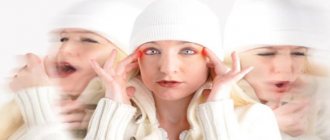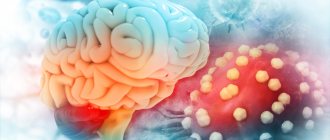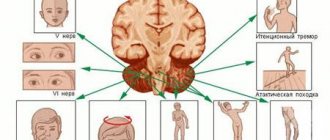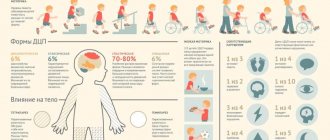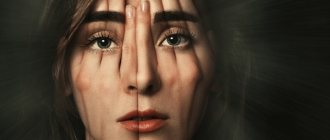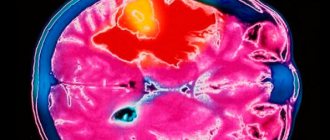Unlike physiological, unconditioned reflexes and instincts, it is consciousness that determines one’s position in society, reflects all manifestations of the surrounding world and reality, and shapes the personality itself. Trying to accurately describe this collective concept, many philosophers argue that this is a kind of reflection of the entire accumulated experience of mankind, necessary for adaptation to the environment. Disorders of consciousness are a broad group of disorders of a number of functions of higher nervous activity, accompanied by complete or partial loss of orientation, the ability to concentrate, and loss of personality traits.
Main etiological factors
The reasons for such violations are related to:
- severe head injuries;
- organic brain lesions against the background of malignant or benign neoplasms, cysts, abscesses;
- infections affecting the functions of the central nervous system;
- alcohol and drug abuse;
- congenital pathologies of the central nervous system;
- psychiatric diseases, in particular schizophrenia, severe psychosis, etc.
- circulatory disorders, formation of hematomas after a stroke.
Identifying the exact cause of the disorder of consciousness plays a key role in determining the tactics of further treatment.
Types and disorders of consciousness
The following types of consciousness are distinguished: clear, darkened, stupor, stupor, coma, delirium, hallucinations.
In therapeutic clinics, patients often experience clear consciousness
. The patient is completely oriented in the environment and clearly answers questions.
Darkened (unclear) consciousness
manifests itself in the patient’s indifferent, indifferent attitude towards his condition; He answers questions correctly, but late.
Stupor (stun)
the patient is poorly oriented in his surroundings, sluggishly, slowly answers questions, sometimes not to the point, and immediately begins to doze off, fall asleep: falls into a state of numbness.
Sopor
- deep confusion of consciousness (dullness). In this case, the patient is in a state of “hibernation”. Only a loud shout, painful effects (injections, pinches, etc.) can bring him out of this state, but for a very short time; soon he “falls asleep” again.
Coma (deep hibernation)
- complete loss of consciousness. The patient does not respond to shouting, painful stimulation or inhibition. In coma there are no reflexes. Coma indicates significant severity of the disease. It develops, for example, in severe diabetes mellitus, in renal and liver failure, in alcohol poisoning, etc.
In diabetes mellitus, in the case of metabolic disorders, mainly carbohydrates and fats, due to a lack of insulin in the body, a hyperglycemic (diabetic) coma occurs. It develops slowly. It is usually preceded by malaise, loss of appetite, headache, nausea, and vomiting. Further, muscle tone decreases, dry skin develops, their turgor decreases, the face becomes pink, the eyeballs become soft, tendon reflexes partially or completely disappear, noisy breathing is noted (Kussmaul breathing), a characteristic odor of acetone (fruity) is felt in the exhaled air, pulse slows down, blood pressure drops.
With adrenal insufficiency, as well as with an overdose of insulin and for a number of other reasons, a hypoglycemic coma occurs as a result of a sharp decrease in blood sugar levels. It starts quickly. Sometimes it is preceded by a feeling of hunger, weakness, and sweating. With this disease, the skin becomes pale, moist, muscle rigidity, body tremors, convulsive twitching are noted, and the pupils dilate.
Due to severe diffuse liver damage as a result of complete failure of its function, hepatic coma develops. In this case, severe weakness and drowsiness appear, alternating with periods of excitement. The skin becomes jaundiced, scratching, spider veins, and hemorrhages are noted. Muscle twitching is also observed, and a sweetish (liver) odor is felt from the mouth. Breathing is noisy (Kussmaul), pupils are motionless, dilated, blood pressure is reduced, urine is dark yellow, feces are discolored.
In patients with chronic kidney disease, accompanied by severe functional insufficiency, uremic coma occurs. Its initial signs are general weakness, headaches, nausea, vomiting (especially in the morning, before meals), general anxiety, and insomnia. Then comes loss of consciousness. The skin becomes pale yellowish, dry, with traces of scratching and hemorrhages. The mucous membranes of the oral cavity also become pale and dry, breathing is like Cheyne-Stokes, less often - Kussmaul, muscle tone increases, and an ammonia smell (smell of urine) is felt from the mouth.
Patients with alcoholic coma are characterized by a cyanotic face, dilated pupils, hyperemic sclera of the eyes, shallow, hoarse breathing, the smell of alcohol on the breath, Cheyne-Stokes type breathing, a small rapid pulse, and low blood pressure.
In the case of an anemic coma, pallor, clammy sweat, muffled heart sounds, thready pulse, decreased blood pressure.
In some diseases (especially infectious diseases with severe intoxication), poisoning with alcohol, sleeping pills and other drugs, patients experience excitation of the central nervous system, i.e., a state opposite to those described above. Such patients are restless and agitated.
In addition, there may be a disturbance in consciousness leading to delirium. Rave
- this is an objectively false, absolutely uncorrectable judgment. With violent delirium, patients are extremely excited, jump out of bed, run somewhere, and experience hallucinations.
Hallucinations
There are auditory, visual, tactile (the feeling of worms, insects, microbes crawling over the body, etc.).
During auditory hallucinations, the patient talks to himself or to an imaginary interlocutor.
With visual hallucinations, patients see something that is not really there, for example, mice that rush at them, devils, etc. This often happens with alcoholism.
Quiet delirium is also characterized by unrealistic ideas, hallucinations, only patients behave outwardly calmly, often in a state of stupor or stupor, muttering something, uttering incomprehensible and incoherent phrases.
Delirium
It develops in several stages:
In the afternoon (usually closer to night), signs of general excitement appear. Speech speeds up - often it becomes incoherent, meaningless and inconsistent, facial expressions become more animated, and excessive motor activity occurs. The patient sleeps very poorly and is bothered by realistic dreams. Tactile sensitivity sharply worsens - almost any touch makes you flinch. Characterized by mood swings and causeless anxiety.- Anxiety increases, and this feeling is accompanied by visual hallucinations, which in turn cause severe fear. Illusions are distinguished by their realism and bright emotional coloring. A person ceases to orient himself in time and space, but consciousness is partially preserved.
- Symptoms reach their peak. Total insomnia is possible, hallucinations become more frequent and become even more realistic. Visual illusions are “joined” by auditory ones. But if visible images appear in close proximity, illusory sounds usually come as if from afar - from the street, from behind a wall, from ventilation shafts, etc. Physical activity is typical, which is quite dangerous - trying to escape from illusions, a person can jump out of a window or injure himself in another way. Symptoms worsen in the evening, visions become frightening.
There are several types of delirium:
- alcoholic, which occurs against the background of long-term binges, lasts up to 3-4 days, after which the alcoholic “falls” into deep sleep, then in most cases the symptoms disappear;
- exaggerated, most often manifests itself against the background of various encephalopathies. Symptoms are characterized by monotonous movements, repetition of the same words and sounds. Oral automatisms often occur and the temperature rises. Such an episode is forgotten;
- professional, which is characterized by repetitive movements associated with habitual activities (sewing, washing, ironing, printing, etc.). Usually accompanied by rapid heartbeat, hyperhidrosis, facial flushing, and fever.
Syndromes of disorder of consciousness: forms and symptoms of confusion
In psychiatry, the definition of clear (normal) consciousness usually means the normal status of a mentally healthy person in a state of wakefulness. The main criteria for a clear consciousness of an individual are:
- full perception of external stimuli;
- behavioral and verbal demonstration of an adequate assessment of the situation;
- ability to focus attention;
- orientation in time and space;
- holistic perception of one’s own personality and interest in the existing “I”.
- memory – the ability to preserve and reproduce previous impressions, knowledge, skills;
- thinking - the ability of an individual to reason in the process of reflecting phenomena and events of objective reality in their own ideas, judgments, concepts;
- speech – successful use of speech function, the presence of an extensive vocabulary and appropriate use of words from the lexicon;
- perception is the ability to assimilate, distinguish, and form images of objects and phenomena of the external world in the mind.
- abstract thinking - the ability to think abstractly using abstract concepts in order to abstract from minor details and develop the optimal solution;
- the ability to creatively process received information;
- the ability to carry out the process of cognition and assimilation of new experience;
- the ability to plan, organize and control one’s actions;
- the opportunity to imagine and fantasize.
- switching off consciousness (quantitative disorders)
- clouding of consciousness (qualitative changes).
- nullification;
- stun;
- doubtfulness;
- sopor;
- coma.
- the patient's detachment from reality;
- vagueness, fragmentation, difficulties in perceiving ongoing events;
- isolated or existing simultaneously various forms of disorientation - in space, time, events, one’s own “I”, surrounding people;
- incoherent thought processes;
- inability to develop adequate judgments;
- various speech dysfunctions;
- forgetting events partially or completely that occurred during the period of depression of consciousness;
- the likelihood of retaining in memory memories of psychotic inclusions that arose during the period of oppression of consciousness - hallucinations, delusional ideas, illusions.
- delirium;
- oneiroid;
- amentia;
- twilight stupefaction.
- simple;
- paranoid;
- delirious;
- oneiroid;
- dysphoric;
- oriented;
- hysterical.
Full consciousness is due to the full implementation of cognitive functions - higher cognitive functions of the brain, such as:
A clear state of consciousness also implies that the subject has retained and used in full:
A normal state of consciousness is ensured by the full functioning of the cerebral hemispheres and their relationship with the mechanisms of the reticular formation - a set of neurons, cell clusters and nerve fibers located in all parts of the brain stem and in the central parts of the spinal cord. Syndromes of disorder of consciousness in domestic psychiatry are traditionally divided into two broad groups:
Quantitative disturbances: options for switching off consciousness
Quantitative shifts, also called non-productive or non-psychotic disturbances of consciousness, imply to what extent (degree of severity) the individual’s consciousness is depressed. Based on the level of decrease in the functioning of consciousness, the following types of disorders are distinguished:
It should be noted that if the symptoms of the underlying pathology are aggravated and the disease progresses, then the above pathologies develop one after another. Nubilization is the easiest form of quantitative shifts. The individual resides, as it were, in a “foggy”, “veiled” world. The person perceives reality poorly. All types of reactions to external stimuli occur at a low speed. Motor activity is significantly slower. The subject can “freeze” in one position for a long time, fixing his gaze on one object. There are no purposeful and meaningful eye movements. First of all, the speech function suffers: the individual has difficulty perceiving the question put to him and giving an answer after a certain time interval. There are often reservations and errors in answers. The patient becomes inattentive, uncollected, and absent-minded. In some cases, there is a careless mood, foolishness, and a tendency to make inappropriate jokes. The state of numbing can last for several minutes, after which the person becomes enlightened. However, if the patient suffers from a psychoorganic disease of syphilitic origin - progressive paralysis at the initial stage, this form of depression of consciousness can exist for a long time. If a patient has a benign or malignant brain tumor, obnubilation almost always turns into more severe forms of depression of consciousness. With severe intracranial pathology and metabolic disorders, the patient's condition may worsen, even to the development of coma. Stunning
Implies a pathological mental state in which the individual has a significantly increased threshold of sensitivity to all stimuli originating from the environment.
At the same time, there is a significant deterioration in all cognitive abilities. The patient is in a drowsy state and indifferent to what is happening. The speed of thought processes slows down, the quality of thinking deteriorates. A person loses the ability to form associative connections between phenomena. During deafening, the possibility of establishing verbal contact with the patient is preserved. However, he does not immediately perceive the questions addressed to him. In this case, the patient can only perceive relatively simple requests. A significant depletion of the vocabulary is recorded. The individual’s statements are characterized by vagueness and lack of brightness. The patient gives short, often monosyllabic answers. Meaningless repetition of the same words may be recorded. Difficulties in memorizing and reproducing information are established. Self-orientation is preserved. The patient names his personal information correctly. However, the patient has poor orientation in time and space. Stunning in most cases develops as a result of severe cerebrovascular accidents. Also, this type of depression of consciousness can occur as a result of complex damage to various brain structures. Many or all of the events that happen to a person during a stunned episode are not remembered. Doubtfulness
is a half-asleep state of a person.
There is practically no physical activity. The individual is almost always in a lying position. He makes no attempt to change position. There are no forms of non-verbal communication observed. The eyes are most often closed. The subject loses the ability to fully perceive the phenomena of reality. A person reacts only to the influence of strong stimuli. There is no spontaneous speech, the patient does not provide any information on his own initiative. However, he is able to correctly perceive very simple questions, to which he gives correct answers after a while. The patient does not understand complex commands and calls. Stupor
is a pathological sleep.
The patient is in a supine position. He is motionless. Eyes closed. There are no facial movements observed on the face. The subject's mental activity is manifested at a minimal level. The ability to perform voluntary activities is completely lost. The ability to carry out reflex motor acts is preserved. It is not possible to establish full verbal contact with an individual. Intense stimuli, such as bright lighting, sharp sound, impact on pain receptors, lead to the appearance of stereotypical protective motor and vocal reactions. As the state of stupor deepens, the subject is completely deprived of clarity of consciousness, and an unconscious state occurs - coma. Coma
A comatose state involves a complete loss of lucidity.
The subject has no reactions to all stimuli, regardless of the strength of their influence. The individual cannot be brought out of the coma state even with intense external stimulation. More than 65% of comatose states are associated with a wide range of metabolic disorders, both endogenous and exogenous. About 35% of all clinically recorded coma states are the result of destructive changes in various parts of the body. Qualitative disorders: variants of clouding of consciousness
Qualitative disorders are also called productive or psychotic disorders. Despite the existence of various variants of clouding of consciousness, all these pathological conditions are characterized by the presence of a number of similar symptoms:
It is worth pointing out that only the presence of all the above signs in a patient gives reason to assume that a qualitative form of clouding of consciousness has developed. Several variants of stupefaction are described in the medical literature:
Delirium
Delirium syndrome is one of the most common types of qualitative stupefaction.
The main symptoms of delirium are the occurrence of true hallucinations in the patient from the visual analyzer. The patient’s actions exactly correspond to the content of the hallucinations that arise. Various types of illusions are recorded - distortions in the perception of a really existing object or phenomenon. The patient's emotional state is unstable, and there is a sharp change in affect. The dominant experiences of the individual are obsessive fears. Severe psychomotor agitation is detected. Speech function is animated, facial and motor reactions are accelerated. Sleep disturbances occur: the patient sleeps in shallow, intermittent sleep, accompanied by intense nightmares. He does not comprehend the patient’s appeals addressed to the individual; his answers do not correspond to the questions asked. With delirious syndrome, the ability to navigate the environment is impaired. However, most often the individual is adequately oriented and perceives his own “I” fully. A person who has suffered a full-blown form of delirium retains fragmentary memories of the experiences that took place. He can reproduce details of hallucinations, illusions, and delusions. In certain variants of the course of delirious syndrome, complete loss of memory for the events that occurred is observed. Delirium develops with drug addiction and chronic alcoholism. This type of disorder of consciousness may be a consequence of intoxication of the body. The cause of depression of consciousness may be an acute infectious disease of bacterial or viral origin. Common provocateurs of delirium are vascular pathologies, destructive brain injuries, traumatic effects in areas of the skull of varying severity. Oneiroid
Oneiroid syndrome is characterized by a sudden, involuntary appearance of fantastic ideas in the patient.
The emerging scenes represent significantly modified elements of previously seen, read, listened to information or personally experienced experience. Such fragments of the past are unusually intertwined with a perverted interpretation of actually present details in the environment. The scenes perceived by the subject resemble absurd, “animated” dreams. The plots of the paintings follow each other sequentially, which looks as if a person is watching a film. For oneiroid, the constant symptoms are various depressive symptoms, combined with irritability and unreasonable fear, or manic states reaching a degree of ecstasy. Affective disorders are accompanied by severe sleep disturbances. The patient's eating behavior changes. Psychogenic cephalgia and pain in the heart area occur. As the oneiroid becomes aggravated, the patient enters a period of delusional mood. The individual perceives the environment as an incomprehensible, ominous and dangerous situation. He foresees an imminent catastrophe. Subsequently, delusions of staging arise: the subject is convinced that he is a participant or witness to some kind of theatrical production. Verbal illusions and auditory hallucinations occur. Psychomotor agitation sharply turns into motor retardation and emotional devastation. Oneiroid is fixed in metal-alcohol psychoses. It may be a consequence of severe infectious diseases when a microbial agent has affected the structures of the nervous system. Oneiric syndrome may indicate vascular pathologies. This type of impairment of consciousness is determined in severe skull injuries. The duration of oneiroid syndrome is variable - from half an hour to a week. Memories of experienced sensations are fragmentary and scarce. Delayed amnesia often develops: immediately after the end of the oneiroid, the subject remembers the essence of his sensations, and subsequently he completely loses memories of the contents of the oneiroid. Amentia
Amentia syndrome is characterized by incoherence and illogical thinking of the patient.
The person has severe motor impairment. The subject spends almost all the time in bed in the fetal position, making a variety of chaotic and illogical movements. Confusion and helplessness are recorded. It is not possible to establish verbal contact with the patient. The statements of people in a state of amentia are represented by indistinct sounds, broken syllables, and primitive words. The patient most often speaks quietly and in a singsong voice: his messages are devoid of any intonation coloring. He often repeats the same words several times. The emotional status is unstable. A person can be sad and depressed one moment, and the next moment he will be ecstatic and joyful. Hallucinations in amentia syndrome occur in isolated cases. From time to time, the patient may experience fragmentary delirium. The duration of the amentia period can reach several weeks. The subject's memory leaves no trace of the experience. Amentive syndrome most often develops in various forms of psychoses of infectious, intoxication, traumatic, and vascular origin. — a complete article about amentia. Twilight stupefaction
This condition is characterized by a spontaneous and short-term loss of the ability to function normally. The disorder has an acute and sudden onset. Symptoms develop at lightning speed. Twilight stupefaction ends after several hours. With this variant of consciousness impairment, the subject does not completely perceive the phenomena of reality; he is completely detached from events in the surrounding world. The perception of reality is distorted and fragmentary. He is disoriented in his own “I”. The emotional state is dominated by irrational fears, aggressiveness, and sad mood. Vivid visual hallucinations occur. Painful ideas, reasoning and conclusions that do not correspond to reality appear, characteristic of secondary sensory delusions. Typical automated actions are retained in full. At the end of the episode of stupefaction, the subject loses partial or complete memory of the events that occurred. There are several separate forms of twilight stupefaction:
Twilight disorder of consciousness is often observed in chronic neurological disease - epilepsy. The pathology may be the result of traumatic injuries received in the head area. Read more detailed information about the causes and symptoms of certain forms of depression of consciousness in subsequent reviews.
Oneiroid (dream disorder)
A person is completely detached from the outside world, his visions are a kaleidoscope of illusions that are closely intertwined with fragments of reality. As a rule, the development of oneiroid is preceded by severe depression and mania. Involuntary fantasies appear on any topic, and subsequently some people describe their illusions in sufficient detail, and sometimes amnesia occurs, followed by complete or partial restoration of memory.
Visions are associated with travel, divine transformations, global disasters, meetings with alien civilizations, etc. Outwardly, the violation manifests itself as detachment from what is happening around. Facial expressions usually correspond to imagined experiences, but unlike delirium, the person remains motionless.
Sometimes oneiroid is accompanied by somatic symptoms. The temperature may rise to febrile levels. Sometimes there are complaints of pain in the back, heart, throat, and general deterioration in health. After relief of the acute condition, lethargy, weakness, and irritability persist for 10–14 days.
Disorders of consciousness in mental illness
Prepared by: MedWeb
In mental illnesses, various forms of disturbances of consciousness are observed. This article talks about the main ones.
disorders of consciousness, psychiatrist
Impaired consciousness inevitably leads to disorientation and an incorrect attitude of the patient to the outside world. It is also expressed in the patient’s incorrect attitude towards himself. Symptoms of a disorder of consciousness are unique and varied. An example of a change in consciousness inherent in the normal functioning of the nervous system is sleep and dreams.
For mental illnesses caused by drugs (alcohol, etc.), for various poisonings (lead, lamp gas, atropine, etc.), for mental disorders caused by infection (for example, typhus), for head injuries (wounds, concussions) ) pronounced disturbances of consciousness are often observed.
Disorders of consciousness appear in many mental illnesses. They are often unnoticeable. Consciousness is most sharply upset during the acute, violent course of psychosis. There are states of stunned, confused , delirious , twilight and affectively narrowed consciousness . When stunned, external irritations poorly reach the patient’s consciousness, and all mental processes are slowed down; with confusion of consciousness, the flow of mental processes is sharply disrupted: thoughts are fragmentary, perceptions are splintered, statements are incoherent (the patient’s mental life becomes chaotic, and his understanding of the environment and his situation completely disappears). Delirious disorder of consciousness is accompanied by hallucinations (mainly visual), delirium, and fears. Patients in a delirious state are fussy and restless. Their consciousness of “I” is usually not disturbed, although the perception of the external world turns out to be incorrect.
In a twilight state, consciousness is darkened and at the same time completely occupied by some ideas or experiences that absorb the patient’s attention and disrupt his connection with the outside world. The behavior of patients may seem orderly, even expedient, which easily misleads others about the patient’s condition. The possibility of orderly behavior is explained by the fact that patients in a twilight state often strive for a certain goal and, in this narrowed sense, partially perceive reality.
The possibility of dangerous actions arises when the central experience of this period is accompanied by a tense affect of fear, expectation of danger, and delusional ideas dictating any aggressive actions. In twilight states of this kind, serious motiveless crimes (murder, arson, etc.) can be committed. With an epileptic disorder of consciousness (associated with seizures or independent of them), as well as with pathological intoxication, a predominantly twilight state of consciousness is observed.
Affectively narrowed consciousness differs significantly from twilight consciousness. It is related to the external situation and represents a reaction to real life events. The resulting affect of anger, fear, grief, joy limits the object of perception, the choice of actions, and gives these actions an impulsive character. In most such cases, the ability to correctly understand reality and control oneself is not lost. Only in some cases does the affectively narrowed consciousness take on a painful character.
In this case, a series of actions can be observed that are no longer in direct and understandable connection with an external event, performed automatically, sometimes with paralysis of the senses. So, for example, a woman, insulted by her husband, after some time, already in a state of stupor, moving as if in a hypnotic trance, spills kerosene on the floor in order to burn herself, her husband and two very beloved children. When she was prevented from doing this, she remained in a state of stupor for some time, sat motionless, then suddenly began to cry bitterly and hug the children.
Resolving the issue of the state of consciousness is especially important in the forensic psychiatric assessment of so-called temporary disorders of mental activity (pathological intoxication, pathological affect, impulsive actions, twilight states of consciousness).
Twilight disorders of consciousness
They are characterized by an abrupt onset and spontaneous resolution. In this case, the connection with reality is lost with a total loss of orientation. This pattern lasts from several minutes to several hours. At the same time, logical (in accordance with the emerging illusions) behavior is noted. Subsequently, memory loss is typical.
In psychiatry, the following types of twilight disorders of consciousness are distinguished:
- Typical. The behavior practically does not change, but a detached or gloomy, angry expression appears. Sometimes speech disappears completely. At the same time, the patient is restless, wary, and short-term hallucinations are possible.
- Glucinatory. Often develop against the background of epilepsy. Bright, frightening hallucinatory images come to the fore, accompanied by a desire to defend themselves or, conversely, aggression towards others. Speech is either absent or turns into incoherent muttering.
Automatisms. They proceed without delirium, visions, violence. Certain actions are performed (for example, leaving for another city or even country), while from the outside the behavior seems completely normal. There is perhaps a somewhat detached look, but outsiders rarely pay attention to this. Subsequently, people do not remember anything from their actions and deeds.- Fugues are a type of automatism, but they are very short-lived. Not understanding what is happening, the person starts to run, begins to undress, spins around, etc. Continues up to 2–3 minutes.
Disorder of consciousness
There are quantitative and qualitative disorders of consciousness. Quantitative symptoms include stupor, stupor, and coma. Qualitative ones include delirium, oneiroid, amentia, twilight disorders of consciousness, ambulatory automatism, fugue and trance, double orientation. Special states of consciousness include psychosensory disorders associated with a narrowing of consciousness. Exceptional states of consciousness: pathological intoxication, pathological affect, special ethnic changes in consciousness (amok, low, koro, etc.). There are also multiple consciousnesses in multipersonality disorder, and second life syndromes, which are characterized by radical changes in the self without amnesia of the previous self.
Comparative characteristics of syndromes of impaired consciousness
| Syndrome | Orientation | Amnesia after exiting the state | ||
| Personality | Time | Place | ||
| Delirium | + | — | — | — |
| Oneiroid | — | — | — | +- |
| Twilight | +- | +- | +- | +- |
| Amentia | — | — | — | +- |
- no orientation / no amnesia; + orientation is present; +- approximate orientation / partial amnesia
Stunning (raush) is preceded by drowsiness (doubtfulness), in which the patient responds slowly to questions, sometimes with half-closed eyes, he is inhibited and drowsy. Actually, deafness is characterized by all the minimal symptoms of impaired consciousness, that is, passivity of attention, blurred perception, weakened memorization and recollection, impaired comprehension, decreased ability to make judgments and inferences. Euphoria and fussiness are possible.
Patient S., 19 years old, notices that twice during the course of a week he experienced states of fainting, which were expressed in the fact that his vision began to get dark, sounds were removed and turned into ringing, the inside of his stomach seemed to get cold, his body went limp. In these states, he answered questions slowly, turned pale and covered in sweat. After two seconds, the state returned to normal and perception was restored.
It is precisely states of this kind that M.O. Gurevich called it disintegration of consciousness. Sometimes they resemble the processes of physiological falling asleep.
Stupor is a further disturbance of consciousness disorders. Characterized by disorientation, grasping and proboscis movements, muttered speech, and uncoordinated movements. Pain sensitivity, pupillary, conjunctival and corneal reflexes are present.
Coma is a complete loss of consciousness. Characterized by muscle atony, areflexia, mydriasis with absence of pupillary reactions. Quantitative disorders of consciousness are exogenous disorders and are observed in vascular disorders, severe intoxication, endocrine disorders, epilepsy (epileptic coma), after traumatic brain injury and in the terminal stages of dying (vegetative coma). Assessment of the severity of brain damage using the coma scale is given in the Appendix.
Coming out of a coma is often characterized by so-called out-of-body experiences that resemble dream-like (oneiric states).
I clearly saw myself on the operating table and watched as people in white coats were moving faster and faster around me, they were doing something to my body. Suddenly the pain disappeared. Then I moved into a room in which there was nothing, and there was a breath from the ceiling. There was a blinding white light from above, which, like a funnel, sucked me higher and higher. It is an indescribably pleasant state to lose your body. When I returned there was disappointment and pain.
Delirium (delirious syndrome) is characterized by a violation of orientation in place and time while maintaining orientation in one’s own personality, an influx of frightening visual, less often auditory, hallucinations, and fear. Hallucinations are often zooptic (animals, especially often reptiles, devils). The patient's behavior is determined by the content of hallucinatory images. After recovery from delirium, there is no amnesia. Occurs in organic disorders and intoxications and is considered an exogenous syndrome.
Patient K., 68 years old, after interrupting his alcoholic binge, began to see collapsing locks on the wall, people with scary faces surrounded him and tried to strangle him. At the same time I saw a series of flying UFOs. He ran away from home and hid in the forest. During hospitalization, he insisted that he was staying with his friend, who had died several years ago, he named the year and time of year incorrectly, and was confused about dates. There is an expression of horror on his face.
Amentia (amentive syndrome) is characterized by complete disorientation, incoherent speech (thinking), groping movements and partial or complete amnesia after recovery from amentia. When delirium progresses to amentia, one of the first symptoms is muttering and picking movements (delirium delirium). Occurs in organic disorders and intoxications, and also refers to exogenous syndromes.
Patient L., 34 years old. Upon admission to the clinic, he correctly named his passport details, but was disoriented in place and time. I saw people hanging outside the window and felt fear. I didn't sleep for two nights. By the end of the day of admission, he lies within the bed, pulling the blanket over himself with stereotypical movements. Speech is quiet, mumbling, repeating individual syllables, sometimes shouting “I’m coming, I’m leaving.” The gaze does not fixate, looks around, bites its lips.
Twilight disorders are characterized by a narrowing of consciousness with an influx of visual hallucinations, often colored in yellow and red tones (erythropsia) and partial or complete amnesia after emerging from twilight. More common in epilepsy.
Patient D., 30 years old, has a history of epilepsy. For two days I was at the airport with my husband, waiting for my flight, which was constantly delayed. Suddenly disappeared. Then, according to her words, she found herself immediately at home, although she recognized only one room, for some reason immersed in “red darkness” because of special curtains. In fact, she moved 10 kilometers away from the airport, broke a window in a kindergarten and fell asleep on the floor. She could only give an approximate date, although she named the month and year, and believed that “my husband went out somewhere and they had already flown home.”
Oneiroid (oneiric syndrome) is a disorder of consciousness with complete disorientation, an influx of cosmic or apocalyptic visual hallucinations, exit from oneiroid without amnesia. Characteristic of catatonic schizophrenia, sometimes found in cases of intoxication with psychoactive substances and epilepsy. It is considered predominantly an endogenous syndrome.
Patient K., 42 years old. Delivered to the clinic by rescuers. He was discovered in a clearing in a mountain forest, sitting by an extinguished fire. He did not answer questions and followed instructions passively. The state of lethargy and passivity with indifference continued for another week. After recovering from the state, he reported that he had been abducted from the forest by aliens who had been traveling with him “in a beam of light” into the past for about 30 years. I saw how pyramids were built, canals in Mexico, canals on Mars, then dinosaurs. After being discharged, he published an article in an esoteric newspaper about the types of aliens and gave examples of their language, consisting of stretches of the letter “a”.
Ambulatory automatism is characterized by switching off consciousness with automatic actions and amnesia. If such actions are accompanied by excitement, but last up to several seconds (jogging, slamming a door), they talk about a fugue, if for a long time (several days), they talk about a trance. Occurs in epilepsy.
Patient L., 24 years old. Two years ago he suffered a traumatic brain injury. Periodically, headaches with nausea occur. One day he rode his bike to the store and disappeared. Was discovered by police in the city, almost 40 kilometers away, a week later. I couldn’t say my name or pinpoint the date; I didn’t know how I ended up in the city. Neurological examination showed horizontal nystagmus. Confused, trying to remember the events of the past week. Relatives establish that he was passing through neighboring settlements, where he was noticed by acquaintances, but did not react to their responses, “he was looking somewhere ahead.” I lived for several days in an abandoned house, collecting scraps. After the therapy, memory was restored only for current events, but amnesia remained for the period of trance.
Double orientation is characteristic of delusions, for example, delusions of grandeur, when the patient calls himself both a significant person and his name, or with delusions of staging, he claims that although he is in a given place, he still considers it not genuine, staged.
Patient Zh., 30 years old. Political leader of one of the parties. He was brought from a meeting of his party in psychomotor agitation. Oriented correctly in place and time. However, he assures that at the time of the rally, simultaneously with the speeches of the speakers, executions took place behind the stage, and he heard shots. He understands that he is in the department, but believes that all the people have been recruited by opponents. Although he knows the date of hospitalization, he believes that with the help of drugs, those around him are “moved away from the election date by changing calendars.” He calls himself correctly, but believes that at the same time he is “initiated into higher ideas.”
Special states of consciousness include psychosensory disorders in the form of derealization, depersonalization against the background of a narrowing of consciousness.
Exceptional states of consciousness include pathological intoxication and pathological affect. Pathological intoxication is a narrowed state of consciousness, observed when consuming a minimal dose of alcohol, aggression or other unmotivated actions followed by amnesia.
Patient N., 19 years old. Delivered from the pool where he participated in a diving competition. During the swim, he tried to strangle his opponent underwater. When extracted from the water, he behaved inappropriately, rushed at his comrades, tore off his swimming trunks, and screamed inarticulately. The condition became amnesic. When the circumstances were clarified, it turned out that previously the inner surface of the mask had only been wiped dry or washed with water during the swim, but on that day the coach recommended wiping it with alcohol. Previously, N. had never taken strong alcoholic drinks and only tried beer once.
Pathological affect is an inadequate strong reaction to insult, humiliation, loss with a narrowed consciousness, aggression, auto-aggression. Special ethnic changes in consciousness (amok, low, mirriri) also refer to pathological affect. According to the description of ethnographers, the Indian custom of self-immolation of widows after the death of a spouse was often associated precisely with an affective narrowing of consciousness.
Patient S., 35 years old. He was undergoing inpatient treatment for alcohol dependence and was preparing for discharge. I was expecting a visit from my wife and two sons, who were supposed to arrive by car. However, they met with an accident and died. After reporting this event, he turned and ran away, hit a bystander and tore his clothes, causing significant damage to himself.
There is also multiple consciousness in multipersonality disorder, which is characterized by the transition of a personality into another personality with different habits, behavior, name and amnesia of the previous personality.
Stun
Accompanied by partial difficulty in mental activity. Adequate behavior remains, but the train of thought slows down and signs of disorientation appear. The patient answers questions in monosyllables, but correctly, but if they talk to him loudly, sometimes the phrase has to be repeated several times. Sensitivity to painful stimuli is reduced, the patient does not notice discomfort (for example, wet clothes, uncomfortable posture, etc.). Depending on the severity of clinical symptoms, mild, moderate and severe degrees of stunning are distinguished. Subsequently, partial memories are retained.
Impaired consciousness
According to K. Jaspers (1923), the following signs are common to all types of disturbances of consciousness:
- detachment, disorder of direct reflection of real objects and phenomena in the form of difficulty or shutdown of sensory cognition, its fragmentation or distortion associated with deceptions of perception;
- violation of rational cognition, that is, understanding of connections and relationships between objects and phenomena due to impoverishment, shutdown or disorganization of thinking, impaired judgment;
- disorientation in place, time, surrounding persons, and sometimes in one’s own personality. Orientation may be completely absent or false;
- difficulty remembering impressions of ongoing events and subjective experiences, which manifests itself upon exiting the state of impaired consciousness as congrade amnesia. Memories may be incomplete, inconsistent, unclear, alienated, like dreams. Some impressions, on the contrary, come easily to memory and are particularly vivid - the Moly phenomenon. There is also delayed or retarded amnesia, which occurs several minutes or even hours after the end of confusion.
| | A clinical psychologist will correctly diagnose and apply the necessary psychological measures to treat disorders of consciousness |
The diagnosis of clouded consciousness can be established if all four of the mentioned signs are present. But this does not mean that you need to wait for the cessation of acute psychosis and confirmation of the fact of amnesia in order to make sure that consciousness is impaired. It should also be borne in mind that shallow degrees of stupefaction may not be accompanied by obvious disturbances in orientation and the ability to make concrete judgments, even if later all the impressions of this period were lost.
A retrospective assessment of the fact of confusion sometimes has to be given by amnesia for the period of acute mental consciousness, as well as by the content of the surviving memories, which are often very typical for one or another form of confusion. Meanwhile, recognition of the type of clouding of consciousness is not always possible due to its mixed, transitional or very dynamic pictures. In such cases, confusion is stated without indicating its form. A distinction is made between non-productive and productive disorders of consciousness.
Non-productive disorders are characterized by a decrease in the activity of consciousness and the absence of productive psychopathological symptoms (delusions, deceptions of perception). A distinction is made between stunned consciousness, stupor and coma.
Stun. It is characterized by a significant increase in the threshold of perception for external and internal impressions, a slowdown and impoverishment of mental activity towards its complete cessation. Stunning is defined in this regard as a state in which the external with difficulty becomes internal, and the internal becomes external.
In a state of stunning, only intense stimuli cause a response and can attract the attention of patients. Questions are not perceived immediately, incompletely, the meaning of complex questions is not understood. The answers are monosyllabic, imprecise, and usually follow a long pause. Orientation in place, time, and events is incomplete, inaccurate, or completely disrupted. Increased drowsiness, spontaneity, akinesia, and indifference are noted. Affective reactions are extremely sluggish. The background mood can be euphoric. Facial expressions are poor, there is no gesture, the voice is quiet, without modulation. There is no understanding of the painfulness of the condition. Perseverations are observed. Memories of impressions during this period, and sometimes even the fact of stunning, are not preserved. There are no productive psychopathological symptoms, confusion, or fears observed.
Numbing is a mild degree of stunning. Patients give the impression of slightly intoxicated, distracted, uncollected people. They are stupid, do not immediately grasp the meaning of speech addressed to them, are somewhat late in perceiving what is happening, respond and act at random. Patients may be euphoric and fussy. Characteristic are fluctuations in clarity of consciousness and short episodes of inclusion in the situation. In a state of nullification, patients can assess their condition optimistically even with serious injuries. For example, after an injury, a patient makes no complaints, refuses medical care, and tries to help other victims while his own life is in danger. In this regard, patients are not hospitalized, discharged from the hospital ahead of time, or the patients themselves leave the department.
Somnolence is a form of shallow, but less dangerous than numbing, deafening of consciousness. Characterized by increased drowsiness. Left to himself, the patient immediately falls into a deep sleep. For a short time, through vigorous stimulation, he can be awakened, contact can be made, after which he falls asleep again. Somnolence can often be observed after convulsive seizures upon recovery from an epileptic coma. After a seizure, patients seem to sleep deeply for some time and only then come to their senses. It is possible to awaken them, although not without difficulty, but this should not be done - awakening may be incomplete and result in motor agitation with aggression.
Stunning resembles the symptoms of a psychoorganic syndrome (torpidity, spontaneity, weakness of judgment, memory), but is not one. It is observed upon recovery from a coma, but, in turn, can develop into stupor and coma.
Sopor. Only elementary manifestations of mental activity are preserved. In response to a loud call, the patient may, for example, turn his head, open his eyes briefly, or respond to an injection with a grimace of pain, a groan, or jerking his hand away. Various neurological disorders are detected: decreased muscle tone, weakened tendon, periosteal, skin reflexes, etc. Pain sensitivity, pupillary, corneal and conjunctival reflexes are not impaired.
Coma. Complete depression of mental activity. Muscle atony, areflexia, bulbar disorders, mydriasis with lack of pupillary response to light, pathological reflexes, pelvic disorders, etc. are detected. States of “brain death” with artificial maintenance of the functions of internal organs in resuscitation are called superior or beyond coma. Identical to apallic Kretschmer syndrome.
Stunning develops as a result of brain hypoxia, edema and swelling of brain tissue, damage to neurons by toxic products, and the development of acidosis in various pathological conditions (skull trauma, intoxication, vascular disorders, tumors, somatic diseases, etc.). Productive disorders of consciousness include delirium, oneiroid, twilight stupefaction, and amentia.
Delirium. It is characterized primarily by various disturbances of perception: illusions, hallucinations, disturbances of sensory synthesis. Visual illusions (pareidolia) and hallucinations (scene-like, zoological, demonomaniacal, palingnostic, cinematic, polyoptic, macro- and micro-optical, visions of threads, wires, webs, etc.) predominate. Tactile illusions of perception are often observed (the imaginary presence of parasites, reptiles, insects on the skin, under it; sensations of animal bites, blows, injections, cuts, spilling liquid). Some types of tactile hallucinations may indicate the nature of delirium.
In cocaine delirium, for example, these may be imaginary sensations of crystals. Delirium in tetraethyl lead poisoning is characterized by hallucinations localized in the oral cavity - an imaginary sensation of hair or threads. With infectious delirium, visceral hallucinations are possible. Typical delirium is characterized by:
- impairment of remembering what is happening, sometimes - confabulations. Thinking is fragmented, unstable figurative delusional ideas are expressed, and false recognitions are observed. Memories of the period of impaired consciousness are incomplete and incoherent;
- false and constantly changing orientation in place, time, surrounding persons, situations. Self-orientation is mostly preserved. Patients oppose themselves to visions, treat them as external to themselves, and do not identify themselves with them;
- affective lability. There is a rapid change in manifestations of fear, horror, surprise, curiosity, and indignation, reflecting the content of perceptual deceptions. Negative emotional reactions predominate. The latter can be colored by a peculiar humorous attitude towards perceived visions, as happens with alcoholic delirium (“gallows humor”);
- motor agitation, increased talkativeness. Patients are mobile, fussy, constantly feverishly busy with something, hiding, running away, attacking, defending themselves, etc. Sometimes there is an increased responsiveness to speech (for example, the patient can immediately answer questions, also addressed to strangers);
- fluctuations in the intensity of delirious phenomena with their intensification in the evening and at night and weakening during the day. Short-term clarity of consciousness can be observed during a conversation with patients.
There are three stages in the development of delirium. In the first, there is a slight increase in mood, acceleration of associations, influxes of vivid figurative memories, fussiness, hyperesthesia, sleep disturbances, anxious dreams, instability of attention, short-term episodes of disorientation in time, environment, situation, and affective lability. In the second stage, pareidolia occurs, anxiety increases, anxiety and fearfulness intensify, and dreams take on the character of nightmares. In the morning, sleep improves somewhat.
At the height of delirium, in its third stage, hallucinations, agitation, and disorientation are observed. Recovery from delirium is often critical, after prolonged sleep, followed by asthenia. The above-mentioned signs characterize the clinical picture of the typical, most common delirium. Other options are possible (A.G. Goffman). Abortive delirium - its duration does not exceed several hours, hallucinations are observed without disorientation. Hypnagogic delirium - hallucinations occur when falling asleep, but are not observed in reality.
Delirium without delirium - disorientation and fussy agitation are not accompanied by perceptual deceptions and delirium. Systematized delirium - scene-like visual hallucinations are observed, which, unlike oneiroid, lack megalomaniac content and scale. The depth of stupefaction may be insignificant, with partial orientation in place and time preserved.
In severe delirium, the phenomena of stunned consciousness with subsequent total amnesia and neurological, somatic and autonomic disorders predominate. Variants of severe delirium are, in particular, murmuring (mumbling) and professional types. The first is characterized by hyperkinetic, bed-bound excitation, inarticulate muttering and grasping movements - a symptom of carphology (nearby objects are grasped; in more severe cases, grasping movements are performed in the air). In occupational delirium, motor arousal is expressed by automated professional actions. There is no reaction to the environment and contact with patients in severe delirium.
Delirious stupefaction is observed in intoxication, infectious, somatogenic, traumatic psychoses, and organic diseases of the brain. Oneiroid. Dreamlike, fantastically delusional stupefaction. Characterized by the following features:
- an abundance of polymorphic psychopathological symptoms. An involuntary flow of vivid ideas (dreams, figurative mentism), scene-like hallucinations and pseudohallucinations, fantastic delusions, various sensory synthesis disorders, affective disorders, catatonic disorders, phenomena of depersonalization and derealization are observed;
- coherence, consistency of psychopathological experiences, their subordination to a single plot, one theme;
- romantic-fantastic content of painful experiences. Upon leaving oneiroid, patients talk about exciting travels, flights in the Universe, visits to other planets, ancient civilizations, the afterlife, new forms of life, etc. This can captivate patients to such an extent that, returning to real life, they regret about this and for some time they feel the desire to again plunge into rapturous dreams;
- violation of orientation in one’s own personality. Patients do not feel like witnesses to imaginary events, but rather their direct and active participants; they feel like they have been reincarnated into other beings, have died, and have changed their human quality. With delirium, according to a well-known comparison, the patient can be likened to a spectator in the stalls watching what is happening on stage. With oneiroid, the patient is no longer a spectator, he himself becomes an actor, a character, since during psychosis various disturbances of self-awareness arise, affecting the auto-, allo-, and somatopsychic spheres. One’s own body may be perceived as having disappeared, transformed into an uncertain state (cloud, beam, plasma, etc.). The soul “separates” and exists independently of the body, etc. The perception of time is disrupted: centuries, eras flash before the mind’s eye, time can go in any direction, freezes or flows intermittently. Orientation in the environment suffers. It can be partial, incomplete (oriented oneiroid), illusory-fantastic (the environment is perceived in accordance with the content of dreams), double (correct and false at the same time). At the height of oneiroid, there is complete detachment from the environment, the projection of fantastic pictures into the outside world disappears (Tiganov, 1982);
- the lack of connection between the content of painful experiences and the characteristics of external behavior, characterized by the phenomena of catatonic stupor or agitation. Contact with patients is severely limited or absent. By the way a patient behaves in oneiroid, it is impossible to determine what the content of his inner life is at this time. Only a few details of behavior allow one to guess about this: an enchanted gaze directed into space, individual words and phrases, symbolic actions, a mysterious smile, an expression of admiration;
- memories of subjective phenomena during oneiric stupefaction can be relatively complete and coherent. Impressions of what is happening in the surrounding reality are much worse reproduced or completely forgotten. There are depressive and expansive variants of oneiric clouding of consciousness.
In the first of them, the content of dream dreams is consonant with the prevailing depressive affect (scenes of hell, world cataclysms, etc.), in the second - with an elevated mood (exciting space travel, pictures of paradise, etc.).
In the development of oneiroid, observed in the clinical structure of attacks of recurrent schizophrenia, several stages are distinguished (Papadopoulos, 1967).
At the stage of clinical precursors of oneiroid, the dynamics of mental disorders are as follows.
The initial stage of the development of an attack is expressed by general somatic and affective disorders. Malaise, headaches, paresthesia, fainting, vomiting, low-grade fever and other general phenomena are observed. Affective disorders include mild depression, hypomania, alternating hypomania and depression. With depression, there is mild melancholy with irritability, capriciousness, touchiness, asthenia, drowsiness, overvalued education, sensitive ideas of relationships, hypochondriacal disorders. When mood increases, attention is drawn to excessive activity with hypersociality, “excellent” health and other disorders. A hypomanic state can have the character of a productive mania, but as agitation increases, the patients’ activities turn into a chain of unfinished undertakings.
At the stage of delusional affect, pronounced affects of fear, anxiety, increased confusion, various affectively saturated delusional ideas, and delusional behavior are observed. The phenomena of depersonalization are added (a feeling of alteration of the Self, alienation of one’s own mental acts). Episodes of delusional orientation in the environment occur.
At the stage of affective-delusional derealization and depersonalization, against the background of depression with lethargy, excited mania or labile affect, delusional ideas of staging, special meaning, intermetamorphosis, positive and negative doubles develop. A double orientation in the situation is characteristic: along with delusional disorientation, a generally correct understanding of the environment is preserved.
At the stage of fantastic affective-delusional derealization and depersonalization, fantastic delusional ideas appear (antagonistic delusions, delusions of grandeur, high origin, Cotard's delusions). Catatonic disorders are added. A double orientation in the situation, alternating at times with delusions, remains.
Subsequent disorders relate to oneiroid proper. There are three stages in the process of its development.
The first is the stage of illusory-fantastic derealization and depersonalization. It is characterized by an illusory-fantastic perception of reality: the surroundings are perceived as part of a fairy tale plot, an episode of a historical event, a scene of the other world, etc. A delirium of metamorphosis arises, a feeling of one’s own reincarnation into the characters of fairy tales, myths, and legends. Symbolism predominates in thinking: instead of causal connections and real relationships, symbolic connections and magical relationships are established. Among perceptual disorders, hyperesthesia, cinematic hallucinations, negative hallucinations, and pseudohallucinations predominate. Catatonic disorders are expressed. The orientation is delusional.
The second is the true oneiroid stage. The consciousness of patients is filled with dreams, they are immersed in a world of fantastic experiences. There is complete detachment from the environment. Colorful fantastic and romantic events unfold before the “inner eye” (magical initiations, apocalyptic scenes, etc.). Severe disorders of self-awareness (“fragmentation”, “dissolution”, monstrous metamorphoses of the Self) are characteristic. Catatonic disorders are most pronounced.
The third is the fragmentary oneiroid stage. It is characterized by the disintegration of a single storyline of oneiric experiences, their fragmentation, confusion within the dream-like fantastic events themselves. This stage resembles amental stupefaction and is usually completely amnesic.
Oneiric clouding of consciousness is observed in the structure of attacks of periodic and fur-like schizophrenia, with epileptic psychoses (in the form of paroxysms, without the dynamics described above), exogenous-organic and intoxication psychoses. Exogenous-organic and intoxication oneiric states are mostly short-lived, fragmentary, and rarely reach the level of dream-like oneiroid. The content of the experiences is banal, ordinary, and simplified; patients are more accessible to contact and do not exhibit significant catatonic disorders. Oneiric episodes often serve as a prelude to delirious stupefaction, so that it is not always easy to decide what the relationship is between one and the other component of confusion in the structure of psychosis.
Twilight stupefaction . Characterized by the following features:
- sudden onset and end of a painful condition;
- a sharp narrowing of the circle of actual ideas, thoughts and motives, a significant limitation of access to external impressions (probably the origin of the term itself is connected with this: patients perceive only a small part of the environment, just as with the onset of darkness only a little that is nearby is seen);
- frantic agitation of patients, in which extremely dangerous acts and senseless destruction are committed. Outwardly correct and formally ordered behavior, as if pre-planned, can also be observed;
- deep disorientation followed by complete amnesia. In a number of cases, elementary orientation in the environment, correct recognition of individuals, elements of self-awareness - an oriented twilight stupefaction - are preserved. There are episodes of twilight stupefaction confined to sleep. Thus, a patient with polymorphic seizures “suddenly” wakes up from time to time and does something for 5–10 minutes. For example, “looking for cockroaches in the kitchen.” In such states, she understands where she is, recognizes loved ones who are trying to find out what is happening to her, and answers questions. Then clarity of consciousness is just as suddenly restored, she understands that she was inadequate and remembers what she did.
The following types of twilight stupefaction are distinguished. Delusional variant - delusional ideas predominate, delusional behavior occurs. Amnesia here is incomplete - when questioned, patients report individual details about the delusional experiences that arose during the period of disturbance of consciousness. The hallucinatory variant is characterized by the dominance of frightening illusions, auditory and visual hallucinations, a state of hallucinatory excitement, and sometimes partial or delayed amnesia. In childhood, some types of night terrors can occur in this type.
Dysphoric variant - affective disturbances prevail in the form of anger, rage, fear with relatively mild clouding of consciousness. Dromomanic tendencies may also be detected. Outpatient automatism is paroxysms of a disorder of consciousness with externally ordered behavior such as aimless and fairly prolonged wandering (automatic walking) in the absence of delusions, hallucinations, or affective disorders. Sometimes provoked by a state of alcoholic intoxication. Seizures of ambulatory automatism can be confined to the period of sleep - somnambulism (sleepwalking).
Close to somnambulism is somnambulism - speech automatisms in a dream. In most cases, sleepwalking and sleeptalking are of a neurotic nature and are associated with dissociated sleep disorders. Unlike neurotic epileptic sleepwalking (meaning seizures themselves; neurotic forms of somnambulism can also be observed in patients with epilepsy) are characterized by a certain (like seizures) autochthonous rhythm of occurrence, develop on average much less frequently and usually without connection with the impressions of the past day. It is impossible to awaken an epileptic somnambulist: persistent attempts to do this can contribute to the development of a convulsive attack.
Paroxysms of sleepwalking are observed at a strictly defined time of the night and are reproduced in a stereotypical form. By the way, it should be noted that the practice of folk healers has long used observations about the difference between epileptic sleepwalking and neurotic sleepwalking: a sleepwalker would have a wet rag placed in front of the door or by the bed at night. A neurotic person usually wakes up when he steps on it, while an epileptic somnambulist does not. The next morning, patients feel exhausted, as after a regular seizure, and, as a rule, they do not remember the fact of sleepwalking. Probably similar to neurotic sleepwalking and sleep-talking are expressive acts in sleep. Usually emotions during dreams do not have external expression. But it often happens that patients laugh or sob in their sleep, waking up crying, with tears.
There are psychogenically caused twilight states, characterized by exclusion from the real situation and transfer to a hallucinatory, replacing a traumatic situation for patients. The environment is perceived incompletely, in accordance with painful experiences. The behavior of patients is bright, expressive, maybe even demonstrative. Partial amnesia is possible, covering mostly external events. There may be psychogenic episodes of ambulatory automatism, in particular somnambulism (an example from fiction is Lady Macbeth).
Hysterical twilight stupefaction is observed in reactive psychoses, as well as low-progressive schizophrenia with hysterical dissociative manifestations. A peculiar version of psychogenic twilight stupefaction - amok - was described among the aborigines of the Malay Archipelago. It manifests itself in sudden states of excitement with aggression and homocidal actions. In shamanism, during rituals (the shaman’s “communication” with spirits), the shaman, accompanied by singing and beating the drum, also falls into a hysterical twilight state with frenzy, ecstasy, sometimes ending in seizures.
Twilight disturbances of consciousness occur with epilepsy, brain tumors, pathological intoxication, in the acute period of traumatic brain injury, with vascular, intoxication psychoses.
Prolonged absence. A condition that superficially resembles stunning. Adynamia, apathy, immobility, difficulty perceiving and comprehending impressions, and perseveration are observed. The performance of habitual actions is not impaired, and this makes this condition similar to ambulatory automatism. Wrong things may happen. Prolonged absence begins and ends suddenly, its duration reaches several days. Brief episodes of clarity of consciousness are observed. The EEG reveals changes typical of absence seizures (peak-wave complexes with a frequency of three discharges per second). Apparently, a more adequate name would be “absence status.” In the status of complex absence seizures, various disturbances occur: catatonic episodes reminiscent of psychomotor seizures, twilight states, stupor - all this makes clinical diagnosis without an EEG study very problematic.
Amentia. Characterized by the following features:
- confusion with an affect of bewilderment and symptoms of hypermetamorphosis. There is also a rapid and chaotic change in the external manifestations of various emotions;
- incoherent thinking, incoherent speech, increased talkativeness;
- motor (hyperkinetic) excitation, usually limited to the bed, the breakdown of complex motor formulas. Choreiform hyperkinesis, catatonic disorders, senseless and uncoordinated throwing are observed - yactation, a symptom of carpology;
- deep disorientation in one’s own personality and the environment, followed by total congrade amnesia;
- scattered hallucinations, incoherent delusions, manic and depressive affects, delirious, oneiric episodes preceding the onset of amental confusion itself;
- asthenic phenomena upon recovery from a psychotic state;
- tends to be prolonged - the duration of amentia can be weeks or even several months. Amentia-like episodes observed during acute psychotic onsets of schizophrenia are usually shorter (hours, days).
A distinction is made between classic (confused), catatonic (mostly stuporous), manic, depressive and paranoid variants of amentive clouding of consciousness (Kraepelin, 1927; Meynert, 1980; Korsakov, 1892; Serbsky, 1892; Molokhov, 1961, etc.). It is noted that the classic version of amentia occurs mostly in toxic infectious diseases and the previously identified hypertoxic form of schizophrenia. Amentia has been described in infectious, somatogenic, intoxication, vascular diseases, organic lesions of the central nervous system, reactive psychoses, and schizophrenia. Not all authors identify it as an independent syndrome. Adjacent to amentia is a state of asthenic confusion identified by some authors, the development of which is based on an extreme degree of neuropsychic exhaustion.
Analysis of the clinical structure and dynamics of various forms of disorders of consciousness suggests the existence of important differences between them, indicating the depth of damage to the integrative mechanisms of mental activity. Thus, one can see that congrade amnesia is consistently worsened along the following chain of disturbances of consciousness: oneiroid, delirium, twilight stupefaction, amentia, stupor.
In the same order, impoverishment occurs, the impoverishment of subjective experiences, the aggravation of behavioral disorders, and the increasing vitalization of disorders (if we compare the typical forms of the mentioned forms of confusion).
This scale of disorders of consciousness also shows what combinations and transitions from one form to another are possible and what the clinical assessment of the corresponding tendencies should be. Thus, the transition of oneiroid to delirium or amentia indicates a worsening of the condition. The twilight gloom that occurs after stunning indicates dynamics in the opposite direction. The appearance of professional and exaggerated delirium marks a tendency to transition to a state of twilight stupor, and severe delirium to stunned consciousness. The end point of all forms of stupefaction is stunned consciousness, and then stupor and coma. Back to contents
Sopor
Due to the complete loss of consciousness, this condition is often called subcoma. The patient practically does not react to stimuli, with the exception of loudly and repeatedly repeated questions, and may unconsciously resist any actions (transfer to another bed, give an injection, etc.).
Stupor occurs:
- hyperkinetic, accompanied by meaningless muttering, chaotic movements;
- akinetic, characterized by immobility, but the reaction to painful stimuli remains.
Coma
One of the most severe disorders of consciousness, characterized by its complete loss. There is also no reaction to any irritants, control of almost all vital functions is lost. The depth of coma is assessed on a 5-point scale. The following criteria are taken into account:
- independent opening of eyes;
- physical activity;
- speech;
- reaction of the pupils to light stimuli;
- convulsions;
- breath.
Diagnostic methods
Given the variety of forms of the disease, each case requires an individual approach, and, unfortunately, doctors at the Leto mental health center sometimes cannot help. Thus, patients in a state of stupor, stupor and coma require emergency hospitalization. In such cases, all diagnostic and therapeutic measures are carried out in intensive care units.
Doctors at the Leto clinic diagnose qualitative disorders of consciousness. To determine the cause of the disease, an encephalogram is performed, a computed tomography scan of the brain is required, and, if necessary, a PET scan. We also ask for basic laboratory tests. Sometimes the patient is referred to related specialists.
Cost of services
| CONSULTATIONS OF SPECIALISTS | |
| Initial consultation with a psychiatrist (60 min.) | 3,500 rub. |
| Repeated consultation | 2,500 rub. |
| Consultation with a psychiatrist-narcologist (60 min.) | 3,500 rub. |
| Consultation with a psychologist | 2,500 rub. |
| Consultation with Gromova E.V. (50 minutes) | 12,000 rub. |
| PSYCHOTHERAPY | |
| Psychotherapy (session) | 6,500 rub. |
| Psychotherapy (5 sessions) | 25,000 rub. |
| Psychotherapy (10 sessions) | 48,000 rub. |
| Group psychotherapy (3-7 people) | 3,500 rub. |
| Hypnosis (1 session) | 10,000 rub. |
| Hypnotherapy course (5 sessions) | 45,000 rub. |
| Psychotherapy session with E.V. Gromova (50 minutes) | 12,000 rub. |
| TREATMENT IN A HOSPITAL | |
| Ward for 4 persons | 8,500 rub./day |
| Ward for 3 persons | 9,500 rub./day |
| Ward for 2 persons | 11,500 rub./day |
| Ward for 2 persons Comfort | 12,500 rub./day |
| Ward 1 bed VIP | 16,500 rub./day |
This list does not contain all prices for services provided by our clinic. The full price list can be found on the “Prices” , or by calling: 8(969)060-93-93. Initial consultation is FREE!
Principles of therapy
Drug treatment is indicated. With a deep disorder of consciousness, contact with reality is lost, and not a single psychotherapist is able to “reach out” to the individual. Relief of acute symptoms is carried out in the hospital of the Leto clinic under round-the-clock medical supervision. If necessary, we will arrange transportation to the medical center.
The list of drugs used, their dosage, and duration of treatment depend on individual characteristics and the diagnosis. As a rule, sedatives and drugs for symptomatic therapy are used. After the patient’s condition improves, the patient is discharged, but the doctor must describe in detail the further treatment plan and talk about the need for consultations to correct the treatment plan.
